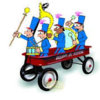Interesting spread of opinion on the merits or otherwise of the various means of powering locos.
I use track power (analogue) and live steam like several others of you and whilst the oldest sections of my track are only 5 years old, I have not experienced any problems with loss of continuity, even where slide on fish-plates are used; conductive grease applied liberally seems to be the answer. I will admit that the track does need cleaning fairly regularly but its not all deposits from LS locos, deposits from trees and bushes, and the local bird life make a substantial contribution; they always manage to perch in exactly the right place to score direct hits on the rails!
Yes dirty track and non-powered sections of point work do cause the occasional hesitation, especially so with 4 wheel locos and the push-pull set directional lamps, which whilst being LEDs, use track power and have been known to flash on and off rather than flicker!
I appreciate the merits of battery power and in fact have a plan to battery power, with R/C, a GRS Hunslet when I get around to building it.
I do use DCC elsewhere, When the new indoor 4mm GWR themed layout was being planned, getting on for 20 years ago, I decided to go digital and invested in Lenz equipment which was the 'thing' at the time and is still going strong with assorted manufacture's decoders fitted in 21 locos and 2 railcars. I do not, however, use sound cards and have no real desire to do so.
Likewise I have no desire to use DCC in the garden, but I will probably try an analogue sound card in one of the 2 diesels to see what its like, and if successful may well try a steam card, probably in the Stainz, as that topic has been well documented elsewhere on this Forum, and then...............

As was stated previously, each to their own and that's mine!




